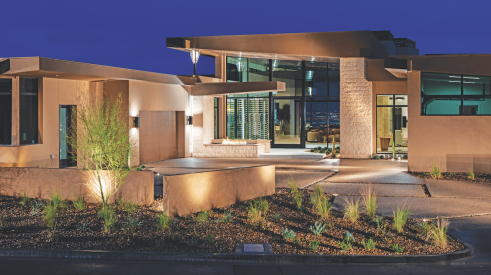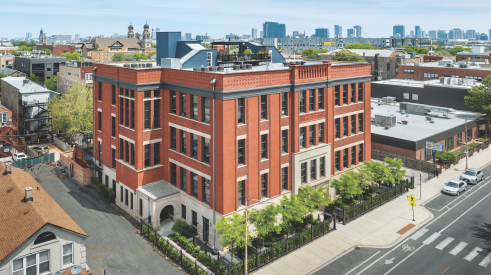 |
||||||||
|
|
||||||||
 |
||||||||
|
These 7-ft deep front porches (above) provide a comfortable sitting area for the family.
|
||||||||
 |
||||||||
|
Traffic-calming devices (above) wind through the community. One of two gathering places (below) for community events.
|
||||||||
 |
||||||||
 |
||||||||
|
Living courts help create smaller neighborhoods within HomeTown. All residents' homes front the shared common walkway.
|
||||||||
 |
||||||||
|
A look into "The Lofts" currently being constructed in HomeTown.
|
||||||||
 |
||||||||
 |
||||||||
|
Parks intertwine within living courts and living lanes.
|
||||||||
Bigelow Homes created its own community within the town of Aurora, Ill. People, and the relationships formed, make up HomeTown, a community designed to encourage people to live out their humanity.
Imagine a community where home buyers can watch their children ride their bikes along the sidewalk from their front porch without the worries of traffic being a danger.
Imagine a neighborhood where residents walk to the community post office each morning to drop off outgoing mail, and stop in at the attached café for a coffee to start the day.
This is HomeTown. A community developed to feed the soul; where friends and families gather together, as well as being an environmentally friendly neighborhood that lives lightly on the land.
"Our definition of neighborhood is the experience of living in a connected community, having as much privacy as desired, but also the ability for the first time since World War II to live in a community designed to encourage people to live out their humanity," states Bigelow Homes owner, Perry Bigelow.
Experiencing The Product
"Most builders put models as far away from the construction site as possible," says Bigelow. "They want people to experience the dream, not the reality."
HomeTown did just the opposite. Bigelow placed models within the construction site. And because of this drastic change in the layout of its models, Perry admits the first year of sales was difficult. "We were building all these houses in the first half of the first neighborhood. People had to drive through all the construction to get to the model complex," says Perry.
During the first year, people literally drove up, pulled into the driveway, backed up, and drove out, claims Perry. "Those people wanted a conventional house surrounded by their moat, and they didn't want to know their neighbors."
Today potential buyers at HomeTown drive right into the heart of the community — over the traffic-calming device, through the park and on to the community store/café. They walk past the post office for the first 100 homes, cross the street, and through the pavilion (a structure used for entertainment or for specialized activities) to the model complex. If the potential buyer has children with, they have the option to drop them off at the tot lot located outside the sales office.
"People arrive at the front door and already think this place is different," says Perry.
What makes HomeTown different? Deliberate planning.
Traffic-calming devices
Safety platforms scatter about HomeTown. Based on a Dutch manual describing traffic-calming devices to use within communities, Bigelow designed concrete risers throughout. While in Holland visiting communities with examples of these traffic-calming devices, Perry picked up a copy of the Dutch manual. Written in Dutch, Perry had the manual translated when he returned to the states.
These safety platforms have a design speed of 12 mph. "Drivers can go over it with 15-16 in. wheels comfortably at about 15 mph," says Perry. "At, 20 mph, it's very uncomfortable and most drivers only do that once."
Other traffic-calming solutions fill the neighborhood as well. Though price certainly impacted the decision-making in planning HomeTown's traffic-calming strategies, it wasn't the main reason. Creating a more neighborhood-friendly overall plan for residents and visitors took precedence over the costly safety platforms priced at $15,000 to $20,000 each.
According to Perry, a traffic-calming device is needed every 200 feet. The parks within Hometown average 150-ft long. "When going past the park, make a sharp turn, then make another sharp turn, go by the park, then make two more sharp turns to continue down the street," says Perry. "Those double-sharp turns, called chicanes, become our preferred way of calming traffic."
With chicanes at each end of the park, they serve the social function of identifying to a person where the center of this neighborhood is. At the same time, they help with traffic-calming every 200 feet. Not to mention, it's easier for fire trucks to move through the chicanes versus driving over the safety platforms.
Parks & Sidewalks
In HomeTown, an "eyes on the street" strategy dictates park placement. "As many houses face the park as possible," says Perry. "The parks are located to create more connectiveness between people, not where it's right from a land engineering standpoint."
Parks cost more when placed on valuable rather than leftover land, but that's part of the HomeTown purpose. "It's part of our central philosophy of developing a real neighborhood," says Perry. In all, on 173 acres in the community, there are 12 parks, complete with tot lots, gazebos and gathering places. It only takes three-minutes or less for residents to walk to their nearest neighborhood park.
What better way to walk to a neighborhood park than on the over-sized 6-ft wide sidewalks winding their way throughout the community. Rather than the typical 4-ft wide sidewalks, Perry thought over-sized sidewalks, while 50 percent more costly, deliver the community-friendly environment that HomeTown creates for its residents.
Bigelow fought the town of Aurora to make its sidewalks 6-ft wide because of the difficulty two people have comfortably walking side-by-side on the standard 4-ft wide sidewalks. "With a 6-ft wide sidewalk, three people can walk side-by-side and it's comfortable," states Perry.
Significant Street Names
To add to the significance of HomeTown, Bigelow purposely named two of its streets:
Living Court Vs. Living Lane
The two basic building blocks in HomeTown - living courts and living lanes - combine to create mini-neighborhood patterns or pocket neighborhoods.
A living lane has houses with garages on the side of the house. "The garages are set back from the house, so people don't feel the impact of those garages as much as on a suburban street," states Perry.
Living lanes cost a bit more to build than living courts because of the pavement of the streets. These streets resemble a conventional suburban street pattern. Evergreen trees serve as the gateway for entering the living lanes.
Each mini-neighborhood controls what happens inside each living court, but Bigelow tries to control what happens on the streets. In certain areas the landscape elevation comes with the house and can't be changed by buyers. "For us the public street is the most important public amenity we have and we want to make sure that architecturally it's the most inviting place that we can make it," claims Perry.
Living courts have the same basic set pattern of a living lane, but the houses form around a courtyard design. A main sidewalk down the center of the living court connects to each home's private sidewalk and front porch. All the front porches, and the main entrances to the houses face out into the living court. This gives a sense of a private courtyard within the neighborhood.
Pattern Language
When it comes to the pattern designs found throughout HomeTown, Perry closely followed Christopher Alexander's A Pattern Language: Towns, Buildings, Construction. This book focuses on ways to create an uplifting environment to the human spirit.
Bigelow uses "something roughly in the middle," - Alexander's pattern for people gathering together at something, whether it be a patio, table or bench, in the middle of the neighborhood. Within each neighborhood, concrete patios cross the middle of the living lane streets, similar to the safety platforms. Only people living on that street may use the patio for personal purposes. Benches and a table placed off the side of the lane on the patio generally find people gathered around it. This same set up is found within the living courts as well. The patio, benches and table all appear within the center of the living court attached by the main sidewalk running through the court.
Another pattern language found in HomeTown - front porches. Instead of being the standard 2- to 3-ft wide porch, the standard depth at HomeTown is 7-ft deep. Perry says Alexander's pattern suggests a porch should not be less than 6-ft deep. In theory, when sitting on a porch and somebody walks by, one might feel less secure or more threatened by the person walking by if the person sitting down cannot look the person walking by in the eyes.
Newest Product in HomeTown
There's more to come in Hometown. Bigelow is in the process of completing the Town Center. Above the Town Center will be the newest housing product for Bigelow - The Lofts.
"HomeTown's Town Center is designed as a greenfield town center," says Perry. The overall density is less compact than downtown Aurora, but more compact than the typical suburban shopping area. A park for meeting and gathering occupies the heart of the Town Center complex with another pavilion for community activities. As HomeTown grows Festival Park becomes the large gathering spot for whole community activities: Christmas tree lighting, community picnics, etc. The trellis at the center of the park already has hosted several weddings.
"We took the land and portioned the land value to the housing, which gives us a low basing and allows us to build commercial spaces economically enough so we can lease it at rates that will support the activity the community has," states Perry.
In creating Town Center, Bigelow hopes to attract tenants that will build a better and stronger community. Possible tenants include: candy shop, ice cream shop, café'/restaurant, salon/tanning spa, barber, florist, bookstore, and health/wellness center, to name a few. Hopefully, residents will also be able to purchase insurance, apply for a mortgage, receive financial advice, and do their banking all within the community. Retail shop square-footage ranges from 880 to 6,160.
Since family, and people in general, are the main focus of HomeTown, a day care center will be attached to the Town Center. Catty-corner from the Town Center, plans for a community church are taking shape as well.
The other reason for the size of Town Center was the development of the loft product. "An urban loft typically looks out a window that's right out on the public sidewalk, and looks across the city. That wouldn't sell in the suburbs," says Perry. With HomeTown's loft set-up, the view out the window is of the pavilion and park surrounding it, which has become a main gathering place for community events at HomeTown.
And, unlike urban lofts, these lofts offer windows on two sides of the building, and have attached two-car garages. Other features include solar tubes that draw natural light into the building.
 |
Reporters of The Front Porch cover all events within the community with pictures to illustrate the events. There's a page dedicated to community life groups and activities that residents can participate in, if desired.
A favorite resident recipe always appears in the current issue along with a message from the neighborhood dog, Bailey Campbell. Upcoming events, a list of newcomers, and newborn babies at HomeTown are listed too.
Advertisement
Related Stories
Design
The New American Home 2024: Modern Features, Timeless Comfort
Explore the design elements and unique, luxe details that combine to create a sense of comfort and relaxed indoor/outdoor living in The New American Home 2024
Design
4 Inspiring Adaptive Reuse Projects With Real Impact
From former schools to warehouses, these adaptive reuse projects—winners in the 2023 Best in American Living Awards—succeed in creating new housing and revitalizing their neighborhoods
Design
Kid-Friendly Home Design Four Ways
Do your ‘family’ homes really deliver great design for parents and their children? Here are four clever home design ideas that consider kids and adults alike






